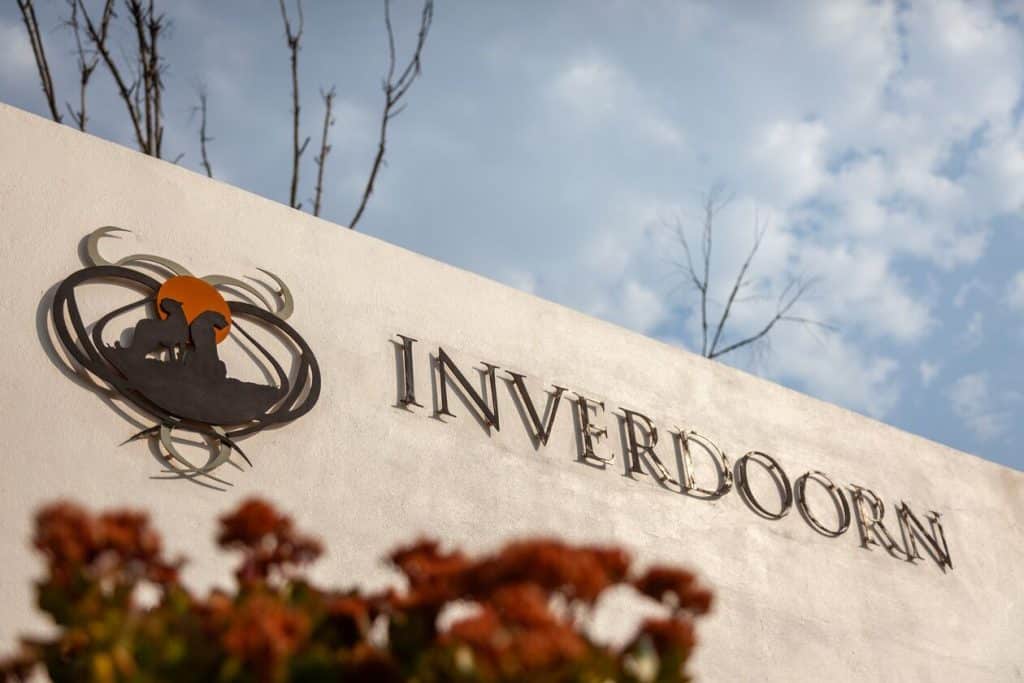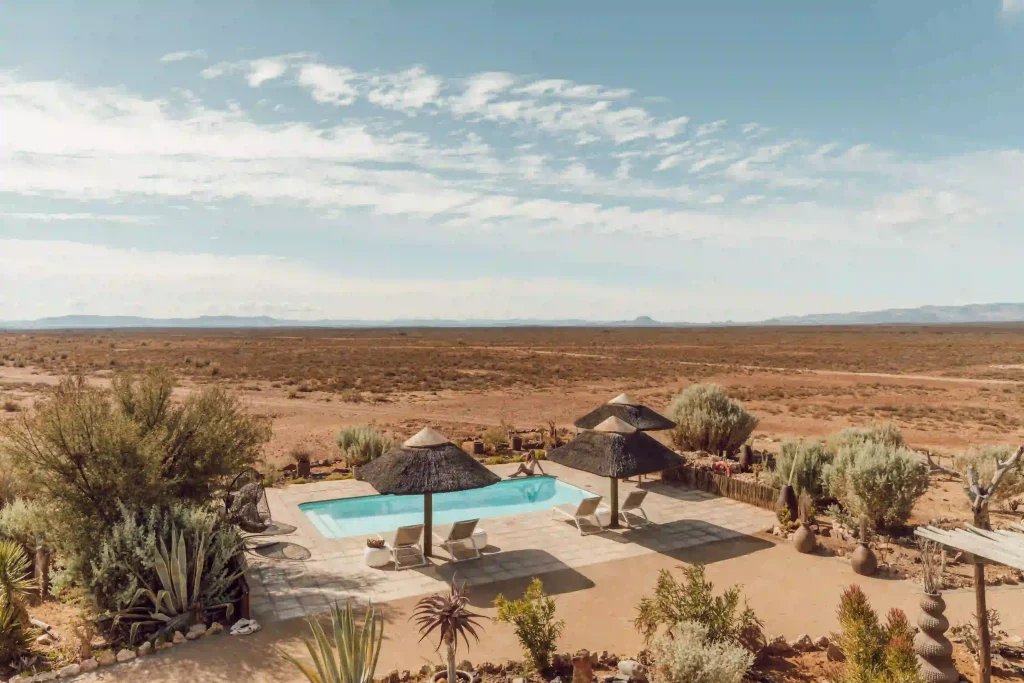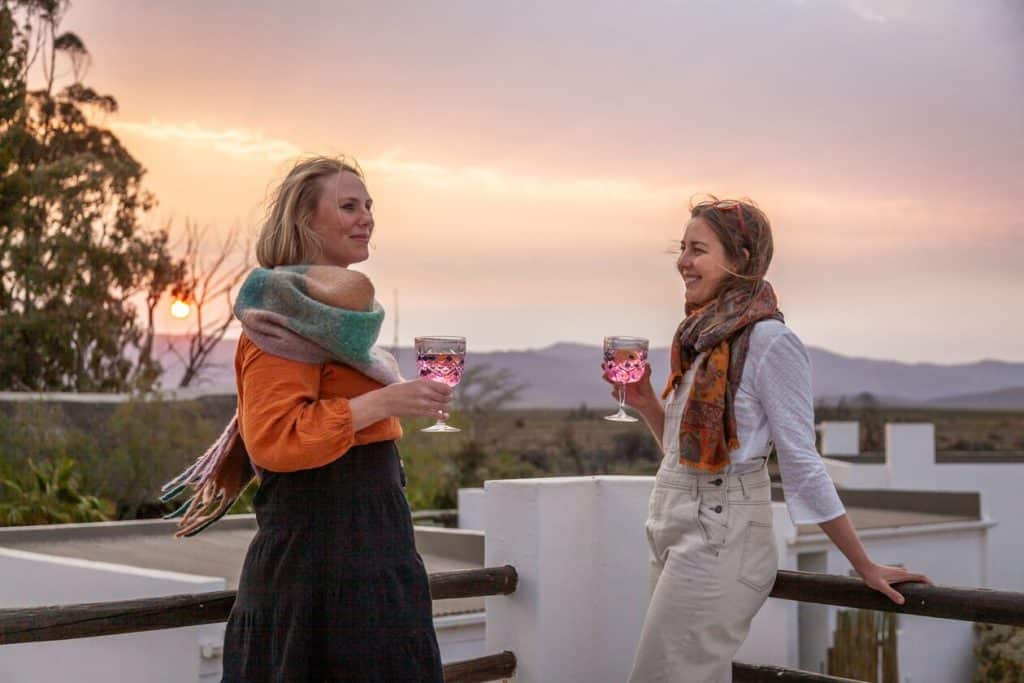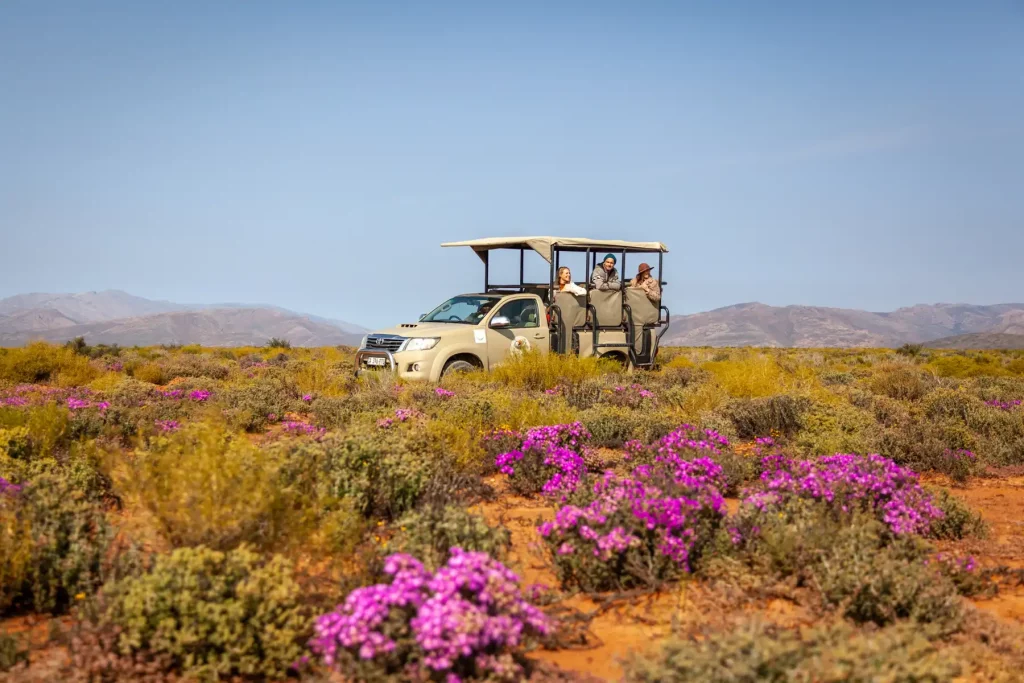Your Guide to the Karoo Seasons
The Karoo seasons can be described in traditional terms (spring, summer, autumn, winter), but their nature and duration are very different to that of the Northern Hemisphere. Winter and Spring intertwine and blend into the rainy season, bringing forth new life and colour; and the summer, which can last up to six months, stretches into warm autumn days with clear blue skies.
Summer
December - February
Summer days are hot and evenings are warm with occasional afternoon rains. For lovers of sunshine and great weather, Western Cape summer days are long and plentiful, with the average sunrise at 06h00 and average sunset at 20h00. Many of the native antelope calve early in the summer and signs of new life can be seen all over the reserve. Rain is always unpredictable in the Great Karoo, and if you are fortunate enough to experience it, the rapid transformation will astound you as the semi-desert landscape transforms with greenery, filling the rivers and dams, and covering the horizon with with a kaleidoscope of wild flowers
Autumn
March - May
Autumn (Fall) in the Karoo brings warm days and cool evenings. The veld takes on a beautiful silky appearance as the succulents and grasslands produce seeds which are blown away by the gentle autumn breeze. As the summer season ends, this is the when most of Inverdoorn’s hands-on conservation work is done, such as the cheetah rehabilitation project. Following the abundance of Summer and Spring, Autumn is also the time of year when most of the wildlife are in their best physical condition. Signalling the start of the breeding season, males will fight to establish territories and begin seeking mates. Autumn is also an incredible time for birdwatchers and birding enthusiasts, as migratory birds are at their most active, foraging for insects, small rodents and fruits as they prepare for the long journey north.
Winter
June - August
Winter in the Karoo witnesses a magical transformation of the semi-dessert landscape. Daytime temperatures are mild and the evening can become cold. Night-time temperatures in July can drop below freezing, and most mornings are greeted with a thin layer of frost that melts under the midday sun. Nocturnal animals and large game emerge in the first rays of daylight to enjoy the warm sunshine and stroll along the dry sand roads. Winter is a spectacle for stargazing, offering clear evening skies and cozy stories around the fire. The shorter days and cooler temperatures provide greater opportunities for game viewing and wildlife sightings as the animals become more active and roam freely without the need to seek shelter from the sun.
Spring
September - November
Spring is a lovely time to visit the Karoo and go on safari. The daytime weather starts to warm up and the evenings are pleasant and cool. Spring is the greenest time of the year. Migrant birds arrive late in October, making birding a rewarding and exciting experience. While cold fronts can still sweep through, rainstorms replace the evening frost, heralding in the Karoo’s rainy season, accompanied by a mirage of golden sunsets that stretch beyond the mountains. Succulent fynbos flowers begin to bloom, ushering in a season of abundance and colour. Meerkats emerge from their dens in anticipation of the rains, rhinos can be seeing grazing on new green growth poking through the ground, and elephants can be heard snapping branches and clearing pathways through the thicket.
Temperatures in the Wild Karoo
Located in South Africa’s wild and untamed interior region, the Great Karoo is a vast and diverse landscape known for its mountainous landscapes and succulent semi-dessert shrublands. Located 2.5 hours from Cape Town, the Karoo seasons and average temperatures follow the same patterns as the Western Cape. But, the further east or north you travel, the more the temperatures will vary from that of the city.
South Africa’s western interior is a semi-desert region (the Karoo) known for it’s low annual rainfall and mountainous landscapes. The Karoo ‘dry’ because the rains in the Western Cape are brought in by the humid sea winds, which travel down over the windward sides of the mountains, resulting in the leeward sides of the mountains remaining mostly dry.
Therefore, the vast Karoo veld receives as little as 500 mm of rain annually.
The average minimum temperature in the Karoo is 9°C (48°F), and the average maximum temperature is 24°C (75°F). However, while the average annual temperatures are relatively moderate, the climate throughout the Karoo seasons can range in the extremes.
Temperatures in the winter can reach below freezing 0°C (32°F), while temperatures during the height of summer can reach above 40°C (104°F).
Comparatively, the average summer temperature in Cape Town, December to February, ranges from around 20-26°C (68-78°F) during the day and 13-18°C (55-64°F) at night. In the, June to August, the temperature ranges from 12-17°C (54-62°F) during the day and 4-8°C (39-46°F) at night.
Each of the Karoo seasons offers a unique and incredible experience, so the best time to visit the Karoo depends on what you want to do or what you want to see.
If you’re hoping to spend all day out in the wilderness exploring the remote landscapes and sighting wildlife, the Winter and Spring months are an ideal time to visit the Karoo. With mild temperatures and higher rainfall, the Karoo landscape is the greenest this time of year.
If you’re longing for a relaxing safari stay or epic 4×4 adventure, the Summer and Autumn months are perhaps your best chance to travel to the Karoo. They dry weather and longer days are ideal for those hoping to get the most out of their trip. The warmer months are great for relaxing by the pool, stargazing under clear night skies, and venturing out for an early morning or sunset game drive.
The Great Karoo is a stretch of semi-desert and mountainous landscapes in South Africa’s western interior. Distinct from the succulent Klein Karoo (Little Karoo) region, the Karoo is home to several villages, small towns, farms, wildlife conservancies, and game reserves.
The Karoo’s semi-arid climate and succulent vegetation means wildlife viewing isn’t much influenced by the seasons. Although Summer and Winter can have extreme temperature variations, the best time to visit is often considered to be early Spring (August to October) and Autumn (April to May). During these months, the days are not too hot and the nights are clear and mild. The blooming fynbos wildflowers, from July to September, are also a favourite time of year to visit the Karoo.
Winter is a great time to visit the Karoo and go on safari in South Africa. As the temperatures cool and the rains sweep over the grasslands, the animals become more active, creating incredible opportunities for wildlife sightings.
Winter is also a great time to visit Cape Town and the Western Cape. As the crowds disappear and summer holiday-makers return home, South Africa’s Mother City transforms with exclusive winter deals, cool temperatures, and accommodation discounts available through May to October.
Summer is an incredible time to visit the Karoo and South Africa. Although temperatures can soar in the midday sun, it’s all comes down to timing. Inverdoorn’s summer safari itinerary is designed to create the best experience of, no matter the weather.
With early morning and late afternoon safari drives, guests will have the chance to see the reserve’s wildlife just as they’re waking up, roaming for food, and visiting the watering holes. Sunrise and sunset game drives are also offer the best opportunity to see nocturnal animals and Africa’s ‘big cats’.
Summer in Cape Town and the Western Cape is a popular destination for many travellers from all over the world. Located only 2.5 hours from the city, Inverdoorn’s big 5 summer safari tours are the perfect escape in between exploring Table Mountain, taking a dip in the two oceans, dining at one of the city’s world-class restaurants, and enjoying the iconic Cape winelands.
Annual Winter temperatures in the Karoo average at 9°C (48°F). However, the Great Karoo plains can reach extreme low temperatures of −15°C/−27°F from June to July.
Annual Summer temperatures in the Karoo average at 24°C (75°F). However, the Great Karoo plains can reach extreme high temperatures over 40°C (104°F) from December to February.

Experience the Magic of the Karoo Seasons at Inverdoorn
Experience South Africa’s wild and natural beauty in every season. From spectacular Summer sunsets to the colourful landscapes of Spring, book now to visit Inverdoorn Private Game Reserve and see the Big 5 only 2.5 hours from Cape Town.





